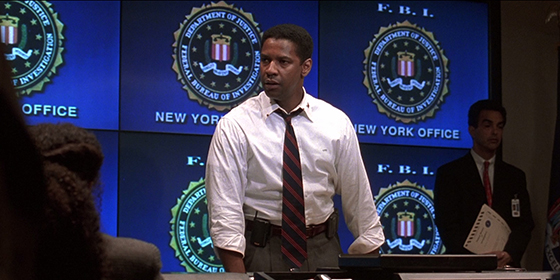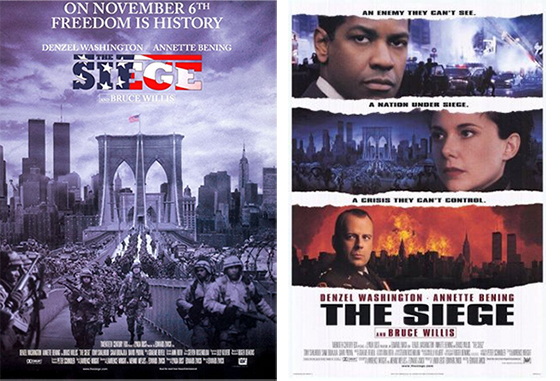The death of Osama bin Laden marks a watershed moment in modern history, but why does a movie from 1998 still retain an eerie relevance?
When the attacks of September 11th, 2001 happened many people remarked that what they were seeing unfold ‘looked like a movie’.
Part of the reason was that the only images shocked viewers could compare them to were scenes of fictional destruction from various disaster movies of the 1990s.
Films such as Independence Day (1996), Deep Impact (1998) and Armageddon (1998) imagined fantastical scenarios where iconic symbols of American power, such as the White House, were spectacularly destroyed by aliens or asteroids.
But by far the most prescient film of this era was The Siege (1998), a drama which imagined a scenario where New York is hit by a wave of terror attacks after an elusive, Islamic radical is captured by the US military.
Directed by Ed Zwick, it explored the dilemas facing an FBI special agent (Denzel Washington), a CIA agent (Annette Benning) and an army general (Bruce Willis) as martial law is declared in a major American city.
The screenplay was by Lawrence Wright, a journalist who would go on to write the award winning book The Looming Tower (2006) which covered the history of Al-Qaeda and the events leading to 9/11.
Picking up on the anxieties of the Clinton era, after the bombing of the World Trade Center in 1993, The Siege explored the ethical choices facing law enforcement when confronted by a ruthless, suicidal enemy.
A box office failure on its initial release, it also resulted in a wave of protests from organisations, such as the American-Arab Anti-Discrimination Committee and the Council on American-Islamic Relations, who felt that it unfairly demonised Muslims.
Even though Zwick engaged with Arab-Americans early in the production of the film, he opted not to soften the depiction of the terrorists in the film.
One sequence, in which a bus is blown up purely for the TV spectacle it will create, seemed tame in comparison with what actually happened three years later, with the destruction of the Twin Towers beamed live around the globe.
But the film also imagined New York being put under martial law, a fantastical plotline which nonetheless touched upon the subsequent debates surrounding the response to 9/11, which involved the real-life use of offshore torture facilities and subsequent debates surrounding the laws passed by the Bush administration.
The Siege isn’t by any means a classic film, even in retrospect, but it was made by serious people with their finger firmly on the pulse of dangers posed by radicalised terrorists.
Looking back on it now, it managed to predict a devastating terrorist attack in New York, a disturbing military response, persecution and profiling of people based on their race and the torture of suspects.
Seeing the original posters for the film, it is hard not to feel an eerie twinge with their use of the Twin Towers and the Brooklyn Bridge.
The same chill is evoked when Bruce Willis’ army general gives a speech declaring martial law against the backdrop of the Manhattan skyline:
In 2009, I asked Zwick about how he looked back on the film from a post-9/11 perspective and he said that he was just picking up on issues that were in the air:
“I wasn’t being prophetic. I was listening to people whose job is to know those things. I felt there was some inevitability that I was keying in to. But when I look at certain aspects of the film that we imagined – the rounding up of people and interrogations and torture – we were tapping in to something that was there to be mined but no-one else was willing to talk about yet. There were many people, in any number of cultures, that were already quite desperately concerned with [terrorism] but it somehow hadn’t found its way in to the popular imagination”
It took several years for mainstream films to explicitly deal with 9/11, in dramas such as World Trade Center (2006) and United 93 (2006), whilst documentaries such as Taxi to the Darkside (2007) and No End in Sight (2007) examined aspects of the wars unleashed by the attacks.
But in the light of bin Laden’s death this week, The Siege retains a strange relevance, which is odd for a film made in 1998 by a major studio (Fox).
The opening sequence depicts an operation in which US special forces capture and imprison a shadowy figure, who appears to be based on the late Al-Qaeda leader.
This is the reverse of what happened last Sunday when Navy SEALS broke into his compound in Pakistan and shot him in the head.
Even in death, bin Laden has provoked more discussion and earlier this week Lawrence Wright spoke to NPR about what his killing may signify:
Let’s apply that logic to current events.
In Wright’s 1998 movie version, the capture of a wanted terrorist leads to reprisal attacks which further divide America.
Now in 2011, could The Siege continue to have a chilling relevance in a post-bin Laden world?
> The Siege at the IMDb
> More on The Death of Osama bin Laden at Wikipedia
> Lawrence Wright
> The Looming Tower at Amazon UK

